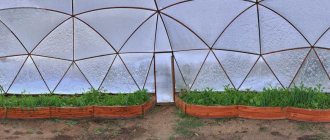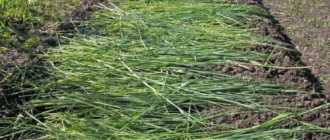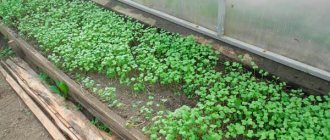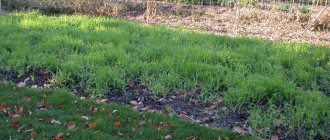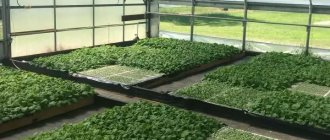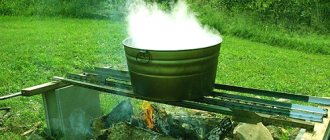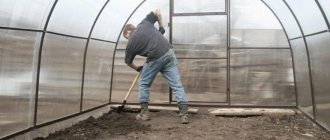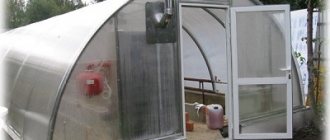Category: Siderates Reading time: 11 min · Views: 10,237
By planting green manure in the fall, you will receive soil prepared for spring work. Not every green manure is suitable for the further cultivation of any vegetables. You need to clearly plan what will grow in the future in this area before planting it. Otherwise, it may turn out that the crop yield will even decrease.
Beginning gardeners notice that over time their vegetables lose their taste and aroma and become watery and faded. This often occurs from a lack of experience, from the fact that the same crops are constantly planted in the same place, and the soil is fertilized incorrectly.
It is impossible for the earth to go “naked” in winter. Something must grow on it. Otherwise, the surface of the soil will freeze and all the microorganisms it needs in the spring will die. The stems that have sprouted in the fall will protect it from this. These plants are winter green manures.
What to do with green manure in the greenhouse in the fall. Green manure: sowing in a greenhouse in autumn
Preparing a greenhouse for the next season is a painstaking and delicate work, if you like, a whole complex of work. The most important task of the activities carried out (from general cleaning, fertilization to disinfection) is to fully prepare the soil for the next sowing season. One of the most important agrotechnical practices is planting green manure in a greenhouse in the fall.
Sofya Poryvaeva / Flickr.com
Deadlines.
The question immediately arises - when? The answer is after harvest, from the end of August until the end of the season. The amount of green mass and when it should be used will depend on the planting date. Green manure sown at the end of autumn will grow only in the spring. They can just be mowed and sealed by the time the seedlings are planted in the soil.
Benefit .
By planting these plants, both in open and greenhouse soil, gardeners “kill several birds with one stone” in one fell swoop. They not only restore, loosen and enrich the soil, but also disinfect it from diseases and pests. Mown green grass eliminates the deficiency of missing microelements.
The benefits of green organics
Green manures are natural organic fertilizers that provide natural nutrition and exchange of nutrients in the soil. Their main advantage is safety for the environment, which is why such plants are often grown in summer cottages. It has been proven that natural fertilizers can increase soil fertility in the garden several times. In addition, they contribute to the accumulation of nutrients in the soil, thereby providing nutrition and support to plants throughout the entire period of development.
Green manure for tomatoes in the greenhouse in the fall. Welcome to my channel, dear readers!
As always, there is a lot of work on the site in the fall. Sometimes there is not even enough time for everything. But I always find time for this processing and pay great attention to it.
This, of course, is post-harvest treatment of the greenhouse. It is very important, since crop rotation in our greenhouses is generally not observed.
We plant tomatoes in the greenhouse in the same place year after year, and in order to get a rich harvest, we need to treat the soil and the walls of the greenhouse well.
After harvesting, I first remove all remnants of plants, weeds, and mulch, with the obligatory removal of them from the greenhouse. Then I cultivate the soil.
I carry out the treatment with this solution. I take 500 grams per bucket of water. iron sulfate and 700 gr. urea. I also add 1 tbsp to the bucket. spoon of citric acid. I use this solution to thoroughly water the soil in the greenhouse. The soil should remain exposed to this solution for a week.
After cultivating the soil, I treat the walls of the greenhouse. To disinfect the walls, I use Whiteness solution. I dilute 1 liter of product in 10 liters of water. I treat the walls of the greenhouse with this product from a sprayer.
After a week, I wash the walls of the greenhouse inside and out with clean water. After washing, I prepare the soil for sowing green manure: I loosen it, add compost, and water it well.
Greenhouse treatment
I sow mixed green manures in the greenhouse. The mixture consists of mustard, vetch, phacelia, and oats. In this mixture, each green manure plays its role, and this has a very good effect on the condition of the soil.
Additionally, after sowing green manure, the soil can be watered with phytosporin, trichoderma or Baikal EM-1. But we do this procedure at a temperature not lower than 10 °C.
I don’t bury green manures in the soil; if they grew tall enough before frost, I cut them off and leave them in the garden bed.
Next year I will plant tomatoes in a greenhouse treated in this way with the confidence that all pathogens have died, and the tomatoes will delight us with a good harvest.
For which crops is it recommended?
This unpretentious grass gets along well with most plants. After applying this green manure, high yields are observed in:
- potatoes;
- tomatoes;
- zucchini;
- cucumbers;
- radish;
- pumpkin and melon crops.
Green manure
Green manures (green fertilizers) are plants grown for the purpose of subsequent incorporation into the soil to improve its structure, enrich it with nitrogen and inhibit the growth of weeds.
Typically, green manure is plowed in before or shortly after the start of flowering as a green fertilizer rich in nitrogen, proteins, starch, sugars, and microelements; at the same time, compost is formed on the surface, the soil is protected from erosion and blowing away. Plant roots improve the mechanical structure of the soil: a system of root tubules is created, worms and microbes that accumulate nitrogen feed on dead roots.
Green manure quickly develops dense foliage, which creates shade and retards the growth of weeds. In addition, some types of green manure (cereals) release substances that delay seed germination, which also reduces the number of weeds. A well-developed root system of green manure helps improve the structure and permeability of the soil: penetrating deep inside, it loosens and enriches heavy clay soils with air, and protects light, sandy soils from crumbling. The roots of green manure also deliver useful substances from deeper layers to the top, closer to the roots of useful crops, between which “green manure” is grown. Green manure planted among vegetable crops partially distracts garden pests. Some green manures can repel pests, for example, radish suppresses nematodes, mustard suppresses scab. In addition, most have bright flowers full of nectar, which attract bees and bumblebees, which simultaneously pollinate neighboring plantings, which helps to increase productivity. Green manures of the legume family are in symbiosis with nitrogen-fixing bacteria, which convert atmospheric nitrogen into a bound state, making it available for consumption by plants. When using green manure, the amount of nitrogen available for further crops is usually 40-60% of the total nitrogen contained in the green manure crop.
Green manure usually performs several functions, improving and protecting the soil:
- (Verticillium wilt) potatoes.
Green manure can also be used to reduce the pH of alkaline soils.
It is believed that about four hundred crops can act as green manure.
First of all, legumes are used for green manure: these are peas, vetch, annual lupine, sainfoin, clover, chickpeas, alfalfa, beans, beans, soybeans, lentils, goat's rue, sweet clover, cowpeas (cowpeas), field peas (pelyushka), china, seradella, etc. Legumes contain colonies of bacteria - nitrogen fixers - on their roots and greatly enrich the soil with nitrogen. Three crops of legumes is the same as a full dose of manure. All of them are cold-resistant, sprout early, and their roots powerfully loosen the ground.
Of the cereal crops used as green manure, winter wheat, triticale and rye, spring barley and oats, sweet and bread sorghum, Sudan grass, paisa, hedgehog grass, chumiza (Italian millet), ryegrass, fescue, bentgrass, timothy, glaucous (non-spreading) wheatgrass
Cruciferous vegetables are also used: white mustard (English), gray mustard (Sarepta), winter colza, winter and spring rape, oilseed radish.
Limitations when using green manure are associated with the expenditure of time, energy and resources (monetary and material) necessary for their successful use. The choice of green manure should be determined by the nature of the region and the amount of precipitation to ensure its effective use.
Ways to use green manure
- St. Petersburg: VIR, 1995. - 432, p.: ill., table..
Digging
Agronomists have different opinions regarding digging. On the one hand, digging allows you to improve the aeration of heavy soil and “deliver” nutrients to the deeper layers of the soil. At the same time, supporters of no-till farming argue that digging up green manure is a violation of the eco-balance of the soil. When moving soil layers, most of the beneficial microorganisms are lost, and erosion processes are aggravated.
When using the second method, the greenery cut in spring is scattered on the surface of the beds, watered with water if necessary, and after a couple of weeks, the soil is slightly loosened and vegetable crops are planted.
Many experienced gardeners note that when using the no-till method, the soil structure actually becomes better and the fertile layer becomes thicker.
Green manure in spring. Why grow green manure?
Green manures are green fertilizers that are grown to restore the physical condition of the soil after the dacha season, improve its fertility and enrich it with nitrogen and microelements.
This name comes from the Latin word “sidera”, which almost literally means “a star that receives power from the sky.” There is something vital in this definition that justifies its purpose.
The most important function of green manure:
- improvement and restoration of the mechanical and chemical composition of the soil,
- additional supply of nutrients.
Green manures are plants that rapidly gain leafy green mass, specially grown to improve and restore the soil and enrich them with nitrogen and various micro- and macroelements. This method of soil fertilization allows you to minimize the use of expensive mineral fertilizers and pesticides. Replacing them with green manure is an economical and environmentally friendly technique.
Advantages of growing green manure:
- the quickly and deeply developing root system loosens the soil well, thereby significantly improving the water and air permeability of the soil;
- create unfavorable conditions for the growth and spread of weeds;
- supply the soil with humus and all the necessary macroelements: nitrogen, potassium and phosphorus, which are not washed away by either autumn rains or melted spring snow in the spring;
- are reliable protection against soil erosion, blowing in winter and erosion in spring;
- their smell and bright color attract beneficial insectivorous animals (toads, ground beetles) to the beds, providing them with food;
- subject to crop rotation, the number of harmful pathogens: pests and diseases is greatly reduced;
- Green manure plants, as fertilizers, during autumn sowing can increase the yield of vegetables by one and a half, or even more times.
In terms of efficiency, a single application of green manure plants is equivalent to the application of 2-3 kg/m² of manure.
Why is there a decrease in soil fertility?
This happens because there is non-compliance with agricultural technology:
- the soil becomes depleted due to the removal of the same elements by a crop that is grown in one place for a long time;
- promotes the accumulation of pests and diseases that affect not an individual crop, but the family as a whole (nightshade, cruciferous and others), their cultivation in one place for several seasons in a row;
- The systematic burning of plant residues dramatically destroys soil organic matter and its structure. A decrease in organic matter leads to sandiness of the soil.
To stop the process of destruction of natural soil fertility, it is necessary to restore and constantly increase the amount of organic matter in the soil. This can be achieved by the following agrotechnical measures:
- switch to cultivating crops using constant mulching of the soil with plant residues. For mulching, use healthy fresh remains of plant crops and weeds (preferably unseeded), straw, fallen leaves, humus, and compost.
- Before autumn digging, systematically add manure (fresh and half-rotted), humus, vermicompost obtained using EM technology, vermiculture and other methods.
- Recently, green manure technology has been increasingly being introduced into agrotechnical measures, which can, in a short period, improve the structure, quality and fertility of the soil, including natural, and significantly increase the amount of organic matter in the soil.
Should I dig up green manure in the fall or not? So is it necessary to plant green manure in the garden bed before winter?
I think that all or almost all gardeners and gardeners know what green manure is. But not everyone understands the impact that certain green manure plants have on the soil. For those who don’t know, I give you a small table that clearly shows this.
I, too, after reading on the internet and watching enough videos on YouTube, decided to sow white mustard mixed with barley in my garden this year.
This is what mustard with barley looks like today
It's getting close to winter. We have already had morning frosts on the soil several times, but mustard and barley have weathered these harbingers of winter well. They are growing, but they are still far from flowering. And I read on the internet that the purpose of green manure is to enrich the soil with nutrition, and the more biomass there is during the budding-flowering period, the more nutrition there is. So I don’t know whether my planting will be of any use if the mustard goes into winter before it blooms? And the most important question is what to do with it when real frosts come - should it be embedded in the soil or not? Gardeners online give many conflicting answers about this. Here is a small example of this discussion on the website https://otvet.mail.ru/: Mustard buried in the ground will rot for a very long time and without access to air it will most likely sour. This is how silage and sauerkraut are prepared - the greens are finely chopped and deprived of air. Manure buried in the ground does not rot for years. Manure spread on the surface is absorbed by the soil and processed by soil living creatures in one season. In nature, no one walks on grass that has died in the fall and buries it in the ground. Cows on pasture, having laid out a “cake”, do not bury it in the ground. Over many centuries of development, nature has adapted microorganisms to process organic matter that dies in the fall. Do not disturb nature by digging, spoil the work of microorganisms and disrupt the structure of the soil. Why do extra work, and even to the detriment of yourself and the soil? Alexey I would not agree with Alexey. In order to get silage, you need to sprinkle the raw materials with saltpeter and close the pit, and then you will get silage. And all agronomists recommend plowing green manure. MILGA MILGA Plowing is unnecessary labor costs. Frost will do its job with mustard and without you. In addition, moisture + frost in winter loosens the soil so that in spring the soil is like fluff. Tested from my own experience. I prefer to bury it in the ground, but no later than August and with the addition of EM preparations (at the depth of a shovel bayonet, the conditions are by no means anaerobic, there is plenty of air there). Green manure planted at a later stage does not rot and remains in the soil for another season. Herbs left in the winter do not produce anything at all; by spring, dry blades of grass remain (Moscow region). Isn't it true, completely different opinions. I think that everyone needs to look for their own methods depending on the region and soil. Elena Akentyeva In general, there are many opinions and there is no single one yet.
Why is there a decrease in soil fertility?
This happens because there is non-compliance with agricultural technology:
- the soil becomes depleted due to the removal of the same elements by a crop that is grown in one place for a long time;
- promotes the accumulation of pests and diseases that affect not an individual crop, but the family as a whole (nightshade, cruciferous and others), their cultivation in one place for several seasons in a row;
- The systematic burning of plant residues dramatically destroys soil organic matter and its structure. A decrease in organic matter leads to sandiness of the soil.
To stop the process of destruction of natural soil fertility, it is necessary to restore and constantly increase the amount of organic matter in the soil. This can be achieved by the following agrotechnical measures:
- switch to cultivating crops using constant mulching of the soil with plant residues. For mulching, use healthy fresh remains of plant crops and weeds (preferably unseeded), straw, fallen leaves, humus, and compost.
- Before autumn digging, systematically add manure (fresh and half-rotted), humus, vermicompost obtained using EM technology, vermiculture and other methods.
- Recently, green manure technology has been increasingly being introduced into agrotechnical measures, which can, in a short period, improve the structure, quality and fertility of the soil, including natural, and significantly increase the amount of organic matter in the soil.
When to plant green manure to improve the soil
Plants to enrich the soil with organic matter are sown at any convenient time of the year, from spring to late autumn.
Advantages of winter sowing:
- It is better to sow green manure in the fall because winter planting allows you to move some of the garden work to the fall, thereby freeing up valuable spring time for field work;
- The growing season of plants is extended. Accordingly, the volume and number of grown stems, leaves and roots increases;
- If you sow green manure before winter, then quickly emerging young shoots in the spring will protect the top layer of soil from the scorching rays of the spring sun and a sharp drop in temperature.
Plants in the garden bed are grown until flower buds begin to form. After budding begins, green manure can be mowed and used for mulch.
Planting mustard in a greenhouse in spring. How to sow mustard correctly?
Mustard is an annual plant of the cruciferous family. It is sown as green manure, honey plant and as an oilseed crop. In this article we will look at its various purposes, and give the timing and features of sowing mustard.
Why do they sow mustard?
In agriculture, in vegetable gardens and summer cottages, mustard is often used as green manure.
Green manure is a group of plants that are grown for subsequent incorporation into the soil before or at the beginning of their flowering phase.
Green manure crops of the cruciferous family include mustard:
- white (English);
- blue (Sarepta);
- yellow.
Let's consider the benefits of mustard sown on the site as green manure:
- enriches the soil with organic substances, nitrogen, microelements;
- extracts and converts sparingly soluble minerals into accessible forms;
- improves the mechanical properties of the soil (the root system loosens clay soils and keeps sandy soils from crumbling);
- forms compost, protects soils from erosion and leaching of useful substances;
- prevents the growth and development of pathogenic fungi and bacteria (for example, scab);
- inhibits the growth of weeds thanks to a developed root system, which prevents weeds from taking root, and the creation of shade;
- reduces crop rotation, allows you to sow the same crops in the same place more often;
- mulches the soil and retains snow on it.
Mustard also has other uses. It is used as:
- Companion plant - beneficial when planted next to the main crop: it attracts pollinating insects and thereby increases the yield;
- repels pests due to the content of essential oils;
- stimulates plant growth due to root secretions.
When does sowing begin?
Mustard is sown during the “rest” of the soil (green manure fallow), in the inter-row spaces during the development of the main crop. Also, depending on its purpose, mustard is grown in spring, summer and autumn.
in spring
Early sowing of mustard is justified as:
- “green manure” (green manure);
- companion plants;
- honey plant;
- source of vitamins and microelements in the human diet.
Thanks to the spring planting of mustard, it is possible to reduce the growth and spread of weeds throughout the area.
Start sowing the crop in early spring, as soon as the snow has melted. Depending on the climate, the start of planting mustard seeds in Russia varies:
- for the middle zone - March;
- for the southern regions - the 20th of February;
- for the northern ones - April.
Focus not only on long-term temperature charts for the region, but also on the weather forecast in case of late spring.
The plant is cold-resistant, can withstand frosts down to -6 °C. Seeds germinate even at +1...+2°C, and at temperatures of 10°C and above, the first sprouts will appear within 3-4 days after sowing.
If you use an annual as green manure:
- Mow mustard before or at the initial stage of flowering (i.e. 30-40 days after planting). By this time, the plant will have gained the optimal volume of green mass.
- Dig up the soil with a shovel.
- Water in dry weather.
Due to the shallow root system, plants are watered abundantly at all stages of growth. - Use EM drugs. These concentrates contain beneficial microorganisms that accelerate the breakdown of plant fibers and promote the rapid formation of humus.
- Plant the main crop no earlier than a week after planting green manure into the soil. Unrotted remains of green mass will slow down the growth of vegetables.
In summer
To restore, improve and enrich the soil, planting mustard in the summer is suitable. During this season, the crop is sown on lands that:
- removed from crop rotation;
- protect from weeds after harvest.
When rotating crops, follow the rules:
- To use the fallow time more efficiently, sow annuals twice a season: at the end of May and in mid-July.
- Keep an interval between sowings of 2 weeks, give soil microorganisms time to process organic matter.
- Mow and plant plants that are in the flowering phase. If you miss the deadline, mustard seeds will form and scatter throughout the area.
in autumn
To prevent the vacated soils from becoming covered with weeds, sow the empty beds with mustard within 2-3 days after harvesting.
It is especially important not to delay agricultural work in the northern regions. Winter starts early there. If you delay sowing, there is a risk that the mustard will not have time to grow before the frost arrives. In the south of Russia, the crop can be planted until late autumn.
In the autumn, it is important to sow mustard as a green manure and to protect the soil from dehydration, freezing, blowing out, and washing out.
There are two ways to deal with grown mustard:
- Mow it if the plants have grown to a height of 17-20 cm. Then they dig it up or leave it lying on the surface of the ground until spring (as mulch).
- They are left in the beds if the mustard has not had time to grow, frost has occurred and the soil is frozen.
Results and conclusions
Rye is a unique green manure that helps to grow an abundant, environmentally friendly harvest of almost all fruits and vegetables. Sowing winter rye is possible both in the south and in central Russia, in the Leningrad region and Moscow region, in Siberia and the Urals, since it adapts perfectly to any climatic conditions.
Rye is a safe precursor for potatoes, tomatoes, cucumbers and cabbage, protecting them from pests. Sowing winter rye does not require special knowledge and skills, so even novice summer residents can cope with it.
